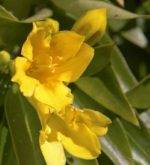 This rapidly growing, climbing or trailing woody vine is evergreen and a member of the logan family, Loganiaceae, a group made up of about thirteen genera many of which are poisonous. It is native from the southeastern seaboard, north to eastern Virginia and west to Texas where it grows in woodlands, fields, fencerows, and thickets but is often grown as an ornamental in both its home range and in southern California. It is the state flower of South Carolina.
This rapidly growing, climbing or trailing woody vine is evergreen and a member of the logan family, Loganiaceae, a group made up of about thirteen genera many of which are poisonous. It is native from the southeastern seaboard, north to eastern Virginia and west to Texas where it grows in woodlands, fields, fencerows, and thickets but is often grown as an ornamental in both its home range and in southern California. It is the state flower of South Carolina.
Description: Paired lanceolate light green leaves are up to four inches long and have smooth margin. They grow on wiry reddish brown stems up to twenty feet long that may climb over shrubs and trees or trail as a three-foot tall ground cover. The bright yellow flowers are fragrant, funnel-shaped and about 1.5” long. They appear singly or in clusters in early spring and give way to flattened capsules with winged seeds.
Poisonous Properties: Plants contain alkaloids including gelsemine, gelseminine, and gelsemoidine, and the root, leaves, and flowers are considered poisonous and consumption can lead to death. Symptoms of poisoning include headache, dizziness, visual disturbances, profuse sweating, depression, convulsions, and respiratory failure. Although the root has been used medicinally, overdoes have caused problems. Children may be poisoned by chewing on leaves or sucking the nectar, honey bees have been poisoned by feeding on the nectar, and livestock has been poisoned by eating the plants.